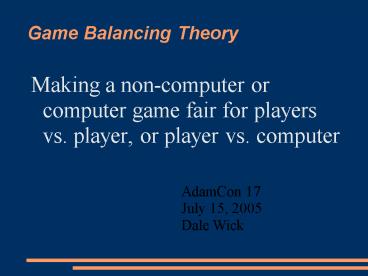Game Balancing Theory - PowerPoint PPT Presentation
Title:
Game Balancing Theory
Description:
Player vs. Player games establishes a ... The simplest architecture with each player with identical strengths and weaknesses. ... ( Tetris, Adictus, etc. ... – PowerPoint PPT presentation
Number of Views:38
Avg rating:3.0/5.0
Title: Game Balancing Theory
1
Game Balancing Theory
- Making a non-computer or computer game fair for
players vs. player, or player vs. computer
AdamCon 17 July 15, 2005 Dale Wick
2
Game Balancing Theory
- Player vs. Player games establishes a
relationship between the players which the player
tries to exploit. - There are four basic strategies for balancing p
vs.p games - Symmetric relationship
- Asymmetric relationship
- Triangularity
- Actors and indirection
3
Game Balancing Theory
- Symmetric relationship
- The simplest architecture with each player with
identical strengths and weaknesses. (One on one
basketball, Rocky) - This type of game is automatically balanced.
- Suffers from a relative simplicity
- Any successful strategy for one side can be used
by both sides - Success is derived from execution, not strategy
- Or success is derived from fine details (a pawn
in Chess)
4
Game Balancing Theory
- Asymmetric relationship
- Each player has unique advantages and
disadvantages. - Must balance both sides to have same likely-hood
of victory, given equal levels of skills - A simple way to do this via plastic asymmetry,
with an initially symmetric conditions, which are
customized with a set of initial traits according
to some set of restrictions.
5
Game Balancing Theory
- Triangularity
- Non-transitive or triangular relationship
- For example Rock-Paper-Scissors
- Pure triangulary does not provide that much
interest - Most often implemented as a combination of
offensive and defensive strengths/weaknesses
6
Game Balancing Theory
- Actors and Indirect Relationships
- Actors are computer controlled characters.
- Indirection is where the player gives the actor a
set of instructions and the actor engages in
direct battle. - The disadvantage is that the player is left to
watch the battle, instead of being directly
engages - Works well with complex scenario where there is a
large number of actors involved.
7
Game Balancing Theory
- Player vs. computer games pits two very different
types of opponents against each other. - The thought processes of a human player is
diffuse, associative and integrated - The thought processes of the computer is direct,
linear and arithmetic
8
Game Balancing Theory
- Creating a game that a human would enjoy, puts
the computer at a disadvantage. - Imaging the following game
- Count all of the numbers from 1 to 1,000,000
- Easy for the computer, tedious for the human.
- Imagine the game minesweeper
- Interesting and easy enough for the human, tricky
for a computer to play. As a result the human
can play easier.
9
Game Balancing Theory
- There are four strategies to balance p vs. c
games. - Vast resources
- Artificial smarts
- Limited information
- Pace
10
Game Balancing Theory
- Vast resources
- Computer is provided vast resources which it uses
stupidly - The computer uses many opponents with rudimentary
intelligence (Slither, Defender, Space Fury,
etc.) - Or the computer uses a one or a few really
powerful opponents with rudimentary intelligence.
(Zaxon, Donkey Kong, Mouse Trap) - Gives a David vs. Goliath air
- Easy to implement.
11
Game Balancing Theory
- Artificial smarts
- Cheaper than the moving mark of fully Artificial
Intelligence (Trolls Tale, Destructor, Chess,
etc.) - Must produce reasonable behavior in every
situation - Be unpredictable
- Moves should be created based upon context and
other player's moves - Must use CO algorithms to compute the next move
in a reasonable amount of time - Combinatorics and Optimization spatial
algorithms like shortest path, decision trees
pruning like alpha/beta searching, etc.
12
Game Balancing Theory
- Limited Information
- If the human player doesn't have the information,
then he cannot apply his superior reasoning to
the situation (Antarctic Adventure, Turbo, etc.) - If applied to excess it turns the game into a
game of chance - Tickles the imagination of the player
- Random gaps in information will be confusing, so
the hidden information must be artfully chosen
13
Game Balancing Theory
- Pace
- The human may be smart, but the computer is fast
at doing simple computations. (Tetris, Adictus,
etc.) - This technique is very easy to use, but has the
disadvantage that it limits the player's
involvement in an immersive experience
14
Game Balancing Theory
- Further reading The Art of Computer Game
Design by Chris Crawford, 1982 - Available as a PDF from Washington State
University at Vancouver (WSUV) transcribed by Sue
Peabody, department of History































